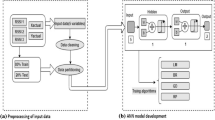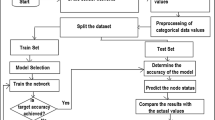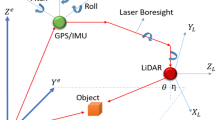Abstract
Wireless Sensor Networks (WSNs) is one of the most widely employed technology because it has numerous applications in almost every walk of life. The analytical results available for large-scale WSNs cannot be utilised to estimate the performance of WSNs deployed in a finite region due to Boundary Effects (BEs). In addition, wireless channel characteristics are affected by diverse environmental phenomena such as the presence of impediments, interference, reflection, and refraction, etc. Therefore, we render an analytical model by considering BEs in the shadowed environments to estimate the \(\kappa\)-coverage metric of a WSN installed in a circular region (CR). Validation of the analytical models is a time-consuming and tedious task and requires hours. To overcome this problem, in this study, we proposed a framework based on feed-forward Artificial Neural Network (ANN) to map the \(\kappa\)-coverage probability using nodes, sensing range, the standard deviation of shadowing denoted by sigma, and required \(\kappa\) as features. These features were extracted through Monte Carlo simulations. We estimated the feature importance and performed the feature sensitivity analysis before training the ANN model. We trained two feed-forward ANN models for with and without BEs. We found sensing range is the most important feature in predicting the \(\kappa\)-coverage probability. Further, the proposed feed-forward framework performs equally well for both cases, with correlation coefficient (R) = 0.98 and Root Mean Square Error (RMSE) = 0.07. Furthermore, it also outperforms the results obtained through the Adaptive Neuro-Fuzzy Inference System (ANFIS).










Similar content being viewed by others
Data Availability
The data will be made available on a reasonable request to the corresponding author.
Code Availability
The code will be made available on a reasonable request to the corresponding author.
References
Tarnaris, K., Preka, I., Kandris, D., & Alexandridis, A. (2020). Coverage and k-coverage optimization in wireless sensor networks using computational intelligence methods: A comparative study. MDPI Electronics, 9, 675.
Priyadarshi, R., Gupta, B., & Arurag, A. (2020). Deployment techniques in wireless sensor networks: A survey, classification, challenges, and future research issues. The Journal of Supercomputing, 76, 7333–7373.
Kandris, D., Nakas, C., Vomvas, D., & Koulouras, G. (2020). Applications of wireless sensor networks: An up-to-date survey. MDPI, Applied System Innovation, 3, 1–24.
Sharma, S., & Nagar, J. (2020). Intrusion detection in mobile sensor networks: A case study for different intrusion paths. Wireless Personal Communications, 115, 2569–2589.
Amutha, J., Sharma, S., & Sharma, S. K. (2021). Strategies based on various aspects of clustering in wireless sensor networks using classical, optimization and machine learning techniques: Review, taxonomy, research findings, challenges and future directions. Computer Science Review, 40, 100376.
Nabi, F., Jamwal, S., Padmanbh, K. (2020). Wireless sensor network in precision farming for forecasting and monitoring of apple disease: a survey. International Journal of Information Technology, Early Access.
Amutha, J., Nagar, J., & Sharma, S. (2021). A distributed border surveillance (DBS) system for rectangular and circular region of interest with wireless sensor networks in shadowed environments. Wireless Personal Communications, 117, 2135–2155.
Tsai, T. R. (2008). Sensing coverage for randomly distributed wireless sensor networks in shadowed environments. IEEE Transactions on Vehicular Technology, 57, 556–564.
Debnath, S., & Hossain, A. (2019). Network coverage in interference limited wireless sensor networks. Wireless Personal Communications, 109, 139–153.
Katti, A., & Lobiyal, D. K. (2020). Sensing coverage for wireless sensor networks in shadowed rician fading environments. Wireless Personal Communications, 110, 1109–1125.
Sharma, A., & Chauhan, S. (2020). Analytic evaluation of non-uniformities for coverage probability computation of randomly deployed wireless sensor network. International Journal of Sensor Networks, 34, 1–14.
Nagar, J., Chaturvedi, S. K., & Soh, S. (2020). Connectivity analysis of finite wireless multihop networks incorporating boundary effects in shadowing environments. IET Communications, 14, 3686–3698.
Gupta, H. P., Rao, S. V., & Venkatesh, T. (2014). Critical sensor density for partial coverage under border effects in wireless sensor networks. IEEE Transactions on Wireless Communications, 13, 2374–2382.
Gupta, H. P., Venkatesh, T., Rao, S. V., Dutta, T., & Iyer, R. R. (2017). Analysis of coverage under border effects in three-dimensional mobile sensor networks. IEEE Transactions on Mobile Computing, 16, 2436–2449.
Liu, Z., Jia, W., & Wang, G. (2018). Area coverage estimation model for directional sensor networks. International Journal of Embedded Systems, 10, 13–21.
Nagar, J., Chaturvedi, S. K., & Soh, S. (2020). An analytical model to estimate the performance metrics of a finite multihop network deployed in a rectangular region. Journal of Network and Computer Applications, 149, 102466.
Singh, A., Kotiyal, V., Sharma, S., Nagar, J., & Lee, C. C. (2020). A machine learning approach to predict the average localisation error with applications to wireless sensor networks. IEEE Access, 8, 208253–208263.
Kotiyal, V., Singh, A., Sharma, S., Nagar, J., & Lee, C. C. (2021). ECS-NL: An enhanced cuckoo search algorithm for node localisation in wireless sensor networks. MDPI, Sensors, 21, 3576.
Singh, A., Nagar, J., Sharma, S., & Kotiyal, V. (2021). A Gaussian process regression approach to predict the k-barrier coverage probability for intrusion detection in wireless sensor networks. Expert Systems with Applications, 172, 114603.
Amutha, J., Sharma, S., & Nagar, J. (2019). WSN strategies based on sensors, deployment, sensing models, coverage and energy efficiency: Review, approaches and open issues. Wireless Personal Communications, 111, 1–27.
Funding
This research received no external funding.
Author information
Authors and Affiliations
Corresponding author
Ethics declarations
Conflict of interest
The author declares no conflict of interest. All the sources are cited, referred and acknowledged.
Additional information
Publisher's Note
Springer Nature remains neutral with regard to jurisdictional claims in published maps and institutional affiliations.
Rights and permissions
About this article
Cite this article
Arora, M., Pal, A. A Deep Learning Approach to Accurately Predict the κ-Coverage Probability in Wireless Sensor Networks. Wireless Pers Commun 127, 2781–2798 (2022). https://doi.org/10.1007/s11277-022-09895-5
Accepted:
Published:
Issue Date:
DOI: https://doi.org/10.1007/s11277-022-09895-5




